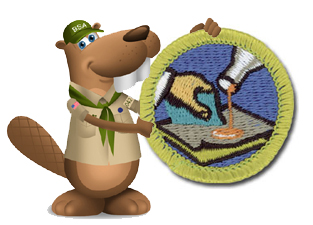Composite Materials


Resources
- Composite Materials Merit Badge Pamphlet
- Composite Materials Merit Badge Class Preparation Page
- Composite Materials Merit Badge Workbook
- Scoutmaster Bucky's Merit Badge Advancement Quick Reference
- Scoutmaster Bucky's Acknowledgement Form
Composite Materials Requirements
Current Scouts BSA requirements
as of December 8, 2025
as of December 8, 2025
1.
Do the following:
a.
Explain to your counselor the most likely hazards you may encounter
while working with composite materials and what you should do to
anticipate, mitigate, and prevent, and respond to these hazards.
Describe the appropriate safety gear and clothing that should be used
when working with composite materials.
b.
Explain the precautions that must be taken when handling, storing, and
disposing of resins, reinforcements, and other materials used in
composites. Include in your discussion the importance of health,
safety, and environmental responsibility and awareness.
c.
Describe what a safety data sheet (SDS) is and tell why it is used.
2.
Do the following:
a.
Explain what composite materials are. Include a brief history of
composites and how they have developed.
b.
Compare the similarities and differences between composites and wood,
aluminum, copper, and steel. Describe the physical, electrical,
mechanical, corrosive, flammability, cost, and other such properties.
For each of these raw materials, give one example of how it can be
shaped and used for a specific application.
3.
Describe how composite materials are made. Then do the following:
a.
Discuss three different composite reinforcement materials, their
positive and negative characteristics, and their uses. Obtain the SDS
for each one and discuss the toxicity, disposal, and safe-handling
sections for these materials.
b.
Discuss three different resins used in composites, their positive and
negative characteristics, and their uses. Obtain the SDS for each one
and discuss the toxicity, disposal, and safe-handling sections for
these materials. Include thermoset resins and thermoplastic resins in
your discussion.
c.
For each of the three resins you chose for requirement 3(b), think of a
new application that might be worth developing.
4.
With your parent or guardian's permission and your counselor's approval do
ONE of the following:
a.
Visit a company that manufactures or repairs products made with
composites. Discuss what you learn with your counselor.
b.
Find three composites-related websites. Share and discuss what you
learn with your counselor.
5.
Do the following:
a.
Use composite materials to complete two projects, at least one of
which must come from the Composite Materials merit badge
pamphlet. The second project may come from the pamphlet OR may be
one you select on your own that has been approved by your counselor
in advance.
b.
With your counselor's assistance, find an appropriate site where the
projects can be safely completed under your counselor's supervision
and/or the supervision of an adult approved by your counselor who is
knowledgeable about composites.
c.
With your counselor, determine how the finished projects will be
evaluated. Using those guidelines, evaluate the completed projects with
your counselor.
6.
Find out about three career opportunities in composite materials. Pick one
and find out the education, training, and experience required for this
profession. Discuss this with your counselor, and explain why this
profession might interest you.